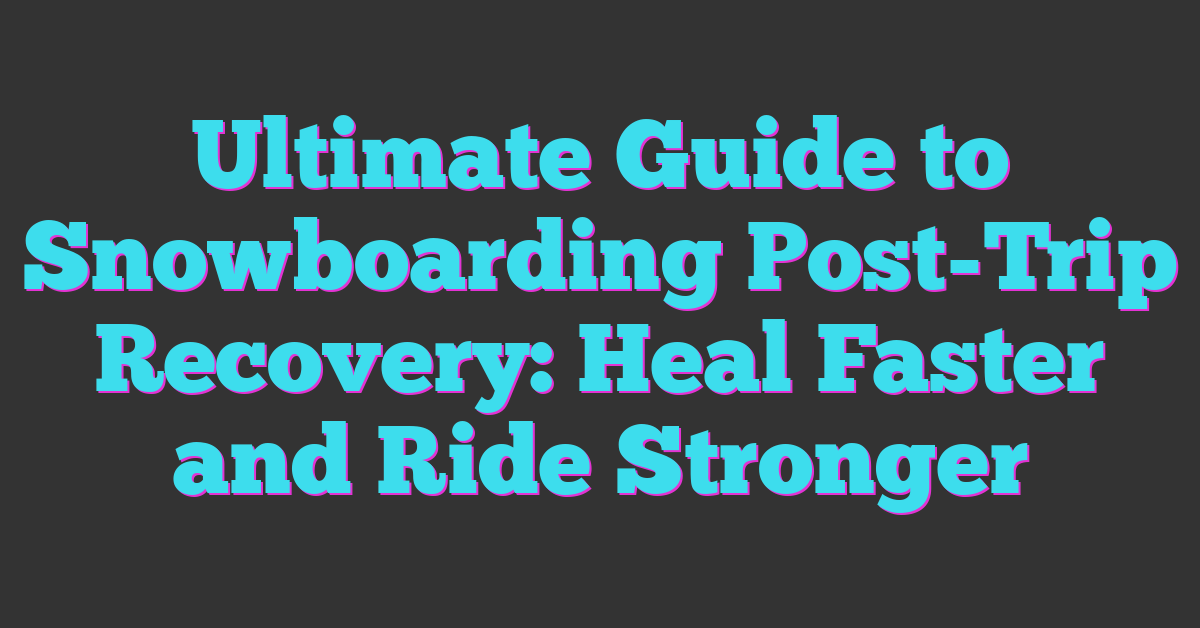After an exhilarating snowboarding trip your body might feel a bit worn out. Whether you’re dealing with sore muscles or just general fatigue it’s important to give yourself some proper recovery time. Taking care of your body after hitting the slopes helps you bounce back faster and keeps you ready for your next adventure.

You don’t have to be a pro to understand that recovery is just as important as the ride itself. With a few simple steps you can ease soreness, reduce stiffness, and recharge your energy. Let’s explore how to make your post-trip recovery smooth and effective so you can keep enjoying the thrill of snowboarding without the lingering aches.
Understanding Snowboarding Post-Trip Recovery
Snowboarding pushes your body and mind in ways other sports can’t. Knowing how recovery works helps you bounce back faster and get ready for your next run with energy and focus.
Common Physical Strains and Injuries
You use muscles that often stay inactive during daily routines, especially your legs, core, and back. Muscle soreness, stiffness, and fatigue appear quickly, mostly in your quadriceps, hamstrings, calves, and lower back. Falls can cause bruises, sprains, or strains, with wrist and shoulder injuries being the most common. Pay close attention to joints like knees and ankles, which experience repetitive impact and twisting. Minor sprains or joint stiffness may linger if ignored, reducing your range of motion and causing discomfort on the slopes.
Mental and Emotional Aspects of Recovery
You don’t just recover physically after snowboarding; your mind benefits too. Mental fatigue from concentrating on balance and navigating snowy terrains builds up throughout the day. Post-trip, you may feel a sense of mental exhaustion paired with a rush of adrenaline that affects your ability to rest properly. Taking time to unwind, reflecting on your ride, and practicing relaxation techniques help clear your mind. Keeping your motivation high while managing any frustration from injuries or setbacks keeps your passion alive and your next trip in sight.
Effective Recovery Techniques
Recovering well after your snowboarding trip helps you hit the slopes with full energy next time. Focus on targeted methods that ease muscle tension, restore strength, and balance your body and mind.
Stretching and Mobility Exercises
Start by gently stretching the main muscle groups you used, like your quads, hamstrings, calves, and lower back. Dynamic stretches increase blood flow, while static stretches improve flexibility and reduce stiffness. Include mobility drills targeting your hips and shoulders to maintain joint range. Spend 10–15 minutes daily on these exercises to speed up recovery and keep your body agile.
Rest and Sleep Importance
Prioritize at least 7–9 hours of quality sleep each night during your recovery phase. Sleep triggers muscle repair and releases growth hormones essential for tissue recovery. Avoid intense physical activities until your soreness subsides. Incorporate short naps if your schedule allows, but don’t let daytime rest compromise nighttime sleep.
Nutrition for Muscle Repair
Fuel your body with protein-rich foods such as lean meats, dairy, or plant-based alternatives to support muscle rebuilding. Hydrate well to flush out toxins and reduce inflammation. Include antioxidants from berries, nuts, and leafy greens to combat oxidative stress caused by intense physical effort. Balanced meals with complex carbs replenish glycogen stores and provide lasting energy, crucial for multiple-day trips.
Managing Pain and Discomfort
Managing pain and discomfort after a snowboarding trip keeps you ready for your next run. Using targeted methods to handle soreness or injuries speeds up your recovery and keeps your passion alive.
Ice and Heat Therapy
Use ice therapy within the first 24 to 48 hours to reduce swelling and numb sore areas like bruises or sprains. Apply an ice pack wrapped in a cloth for 15 to 20 minutes every 2 to 3 hours. After the initial swelling goes down, switch to heat therapy to boost blood flow and relax tight muscles. Heat pads or warm baths for 15 to 20 minutes help ease stiffness in your legs, back, and shoulders.
Over-the-Counter Remedies
Take over-the-counter pain relievers, such as ibuprofen or acetaminophen, to ease muscle pain and inflammation. Follow package instructions carefully and avoid overuse. Topical analgesics with menthol or capsaicin offer localized relief, especially for muscle knots or minor strains.
When to See a Healthcare Professional
Seek medical advice if you experience severe pain, swelling that worsens, numbness, or difficulty moving a joint. Also, get checked if bruises spread extensively or if symptoms last beyond a week despite home care. Timely professional evaluation prevents minor injuries from turning into long-term setbacks.
Enhancing Future Performance Through Recovery
Recovery sets the foundation for stronger, smoother rides on your next snowboarding trip. You build resilience and improve your technique by focusing on recovery as much as on the slopes.
Building Strength and Flexibility
You boost your snowboarding skills by targeting the muscles most engaged during your runs. Regularly train your legs, core, and back with strength exercises like squats, lunges, and planks to increase endurance and stability. Incorporate flexibility routines such as dynamic stretching and yoga poses that improve your range of motion and help prevent injuries. Consistency matters—dedicate at least 3-4 sessions per week to strength and flexibility to see noticeable progress.
Preventative Measures for Next Trips
You minimize soreness and reduce injury risk by preparing smarter for your next trip. Warm up thoroughly before hitting the slopes with light cardio and mobility drills focused on your joints. Use proper protective gear like wrist guards and padded shorts which absorb impact and safeguard vulnerable areas. Maintain hydration and balanced nutrition during your trip to sustain energy and support muscle recovery. Finally, listen closely to your body—take breaks whenever fatigue or pain arises to avoid overexertion and ensure more enjoyable days on the mountain.
Conclusion
Taking the time to recover after your snowboarding trip helps you come back stronger and ready for more fun on the slopes. By caring for your body and mind, you’re setting yourself up for smoother rides and fewer setbacks. Remember, recovery isn’t just about resting—it’s about giving yourself the best chance to improve and enjoy every moment out there. Keep listening to your body and treating it well, and you’ll keep making the most of your snowboarding adventures season after season.










